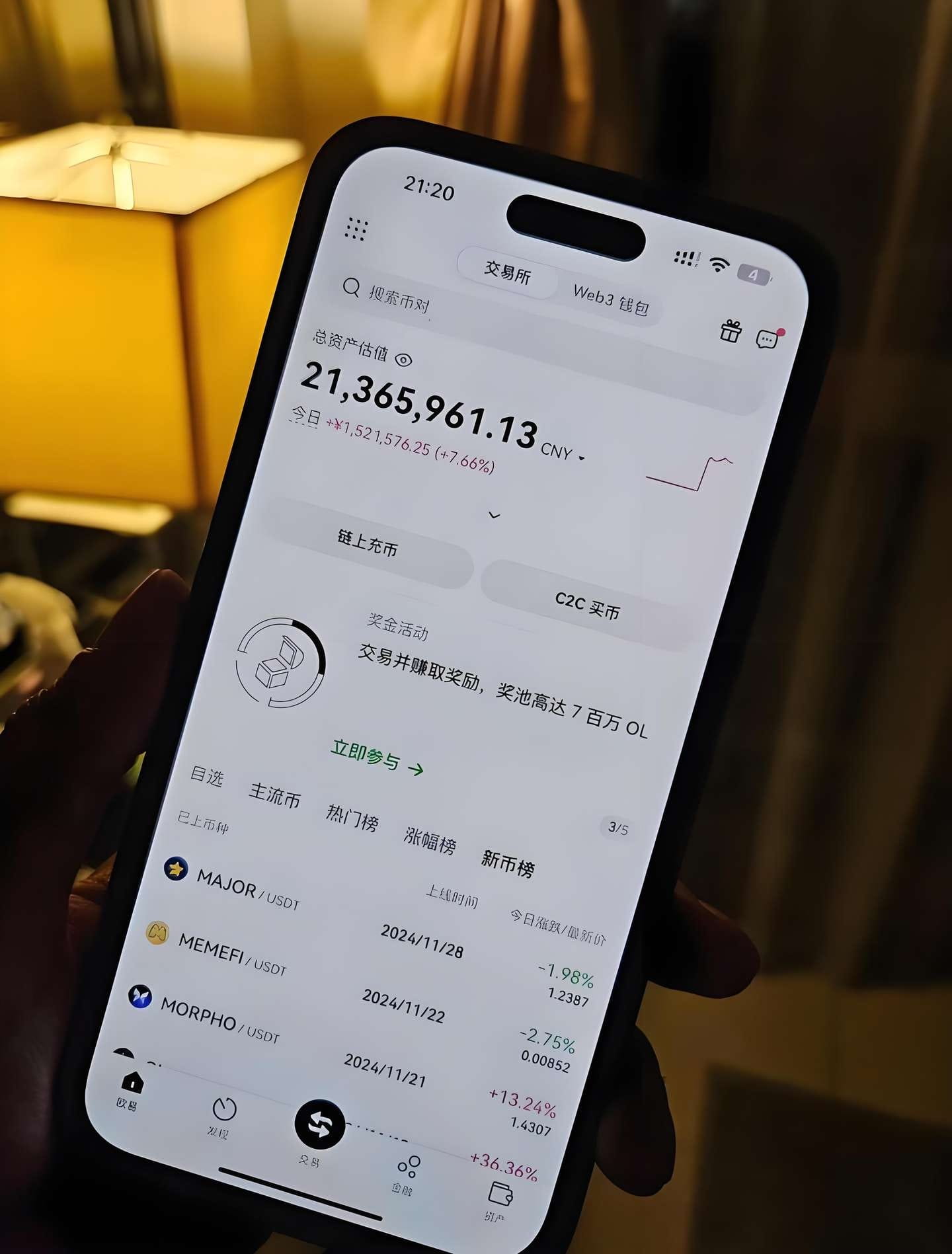After more than a decade in cryptocurrency trading, I lost heavily and was in debt by 8 million in the first three years. After self-adjustment, I achieved financial freedom in the following seven years, with stable compounding, a monthly income of seven figures, and an annual income of eight figures!
If you are currently losing money trading cryptocurrencies, take a few minutes to read this article, and you will find the answer!
First, take a look at my self-reflection after losing 8 million: I realized one truth, only one type of person can make money in crypto trading!
In the crypto world, a day is like a year in the stock market. Those who engage in cryptocurrency trading will no longer have any interest in stock trading. The all-day trading of cryptocurrencies and the lack of limits on price fluctuations fulfill many people's dreams of overnight wealth, which is one of the reasons why virtual currencies are so popular, leading to losses in the crypto world becoming a common phenomenon.
Teaching someone to fish is better than giving them fish. Crypto investors, whether beginners or experts, do not only gain financial returns from Sunny Day but also experience growth in investment knowledge and experience.
In the process of following Sunny Day's investment, Sunny Day not only provides investors with analysis ideas, basic knowledge of watching the market, and methods for using various investment tools, but also brings excellent fundamental interpretations, clarifications of chaotic international situations, and identification of various investment forces.

Let you be both a winner and an expert in investing!
Straight to the point:
If you want to turn 10,000 into millions through cryptocurrency trading, the core is only two points: position management + trend grasp.
Position management:
Divide funds into three portions; for example, 30,000 divided into three 10,000 portions.
Only use 1 portion for each position; do not casually double it. Leverage for mainstream coins ≤10 times, for altcoins ≤5 times.
Take profit when making money, make up losses when losing, and maintain a fixed position for each trade.
Use three portions of funds cyclically; at most, only 1/3 will explode, always keeping the opportunity for recovery.
When capital doubles, then increase the overall position size.
The benefits of doing this:
Diversify positions + use low leverage to reduce the risk of being liquidated by sudden spikes.
Control emotions, leave yourself an exit.
Fixed positions help maintain a stable mindset.
Trading thoughts:
Seize the major trend. Trends are hard to navigate, but they make money. A pullback of 10-20% is a good opportunity to enter.
Set stop-loss and take-profit levels.
Single stop-loss ≤ total funds 5%.
Single profit ≥ total funds 5%.
Win rate > 50%, profit-loss ratio > 1.
The profit formula is simple: total profit = principal × (average profit × win rate - average loss × loss rate). As long as the result is positive, capital can grow.
In summary: Keep your position stable, maintain a cool mindset, if the direction is correct, then dare to go all in during major corrections.
Why does the market always seem to focus on your wallet? The secret of retail investors has long been scripted by the big players!
Have you noticed a ridiculous phenomenon:
As soon as you go long, it free-falls; as soon as you go short, it skyrockets!
Does the market really have 'cameras' specifically watching your orders?
Don't laugh; the logic behind this is more brutal than you think.
⸻
1. The big players do not look at candlesticks, they only look at where you wait to die.
Where do retail investors usually set stop-loss orders?
Integer thresholds, previous highs and lows, right?
What the big players watch every day is not the chart, but the concentration area of stop-loss.
With just a little capital, he can accurately target and blow up positions, then pull back, leaving behind cries of despair.
"Damn, why does the market always go against me?"
The truth is:
The market is not targeting you; it is targeting all the retail investors like you.
⸻
2. Why do you always feel that 'as soon as you close your position, it reverses'?
This is a psychological trap.
• When you cut losses, the big players accumulate positions.
• When you chase highs, the big players distribute their stocks.
The market is a mirror, reflecting not the candlesticks, but human nature:
Fear, greed, herd mentality, and luck.
What the big players need to do is to act against human nature.
⸻
3. Why do you always get harvested?
Because you are too 'normal.'
The thought patterns of the vast majority of people are highly consistent, which is why there is the iron law that 'the majority of people lose money.'
A heart-wrenching statement:
It's not the market watching you; it's you who have become the most standard supporting role in the big players' script.
⸻
4. How to break the deadlock?
• Small positions for testing; don't go all in and lose everything.
• Learn to act against human nature: be greedy when others are fearful, and be fearful when others are greedy.
• Don't focus on candlesticks; focus on 'human nature.'
Remember:
The essence of the market is not about rising or falling, but about the transfer of wealth.
You either get harvested or learn to harvest others.
⸻
⚡ Conclusion:
Next time you want to go all in on a long position, ask yourself:
"Is this what I want, or what the big players want me to want?"
Maybe this knife can help you avoid the harvesting machine.

The dumbest cryptocurrency trading method, yet it has nearly zero failure! (A must-read for beginners.)
In the crypto world, some people lose everything while chasing highs and lows, but today I will teach you a mechanical execution + aggressive compounding four-step method, with a nearly 100% win rate.
Coin selection sniping skills.
Daily MACD golden cross above the zero axis = bullish cryptocurrency, strong upward trend.
Historical backtesting success rate 68%.
Case: Ethereum, April 2024, MACD golden cross after 3 weeks surged 40%, outperforming the market by 2 times.
Be careful to avoid golden crosses below the zero axis; do not get trapped by false signals.
Moving average death line.
Price stabilizing above the 20-day moving average = offensive signal.
Break below the 20-day moving average = unconditional liquidation.
This line is the dividing line between bull and bear; breaking it means the main players are retreating. Don't fall in love with trends.
Positioning art.
All-in charging conditions: Price + trading volume breaking through moving averages (for example, BTC breaking through $60,000 with volume).
Otherwise, only use 50% of your position to test.
Take profit secrets: Take out 1/3 when you gain 40%, take out another 1/3 at 80%, let the remaining profit run.
If it breaks below the moving average, hit the nuclear button and liquidate!
Stop-loss is like breathing.
Break the line and cut losses! Even if it rebounds in a V-shape the next day, don't regret it.
Historical data shows that 87% of liquidation cases are due to 'waiting to see.'
To summarize:
Control your position size, strictly implement take-profits and stop-losses, and avoid greed.
In the crypto world, discipline is 100 times more important than a single profit.

The most practical tip for short-term trading in the crypto world, Sunny Day will directly share a set of basic techniques I have used for the past ten years to turn things around.
Perhaps someone will say that short-term trading is speculation!
First, Sunny Day wants to say that short-term trading is not speculation; real short-term trading is an investment behavior that requires mastery of certain market operation rules and strong skills. Short-term trading is a true test of a person's skill and patience. Those who excel in short-term trading have certainly studied many candlestick charts, analyzed their trends, and summarized general rules. The rules mentioned here are only a probabilistic concept; there can be no completely accurate judgments because the entire market unfolds across multiple dimensions, including emotions and information, with emotions being the hardest to predict. Hence, we can only attempt to make rough judgments.
So how exactly do we do this? We need to learn to summarize historical trades and identify which conditions led to certain trends in historical trading. The role of candlestick charts is indispensable; besides reflecting short, medium, and long-term fluctuations, on a macro level, they can tell you which projects have good market cap management and which ones have collapsed after being dumped, purely harvesting retail investors. For example, we have mentioned several times that there are many fork coins for BTC, but in reality, aside from BCH, the candlestick charts for other fork coins are unwatchable.
These fork coins' candlestick charts have been declining since the beginning, showing little fluctuation, sliding down like a slide, providing no opportunity for retail investors to escape. From their candlestick charts, it is evident that the big players no longer hold large amounts of coins, and these coins are concentrated in retail hands, resulting in no one to drive the price up, effectively becoming a lost cause. Many retail investors trading these coins have transitioned from short-term trading to mid-term trading, then to long-term trading, ultimately becoming passive holders.
As a novice in the crypto world, we need to pay attention to a few points:
1. First ensure the probability of success, then consider the frequency of execution. Pursue quality before quantity. In the process of short-term trading, take it step by step, with the principle of avoiding significant losses.
2. When making money, be content; when losing money, be rational. Trading cryptocurrencies is essentially the art of regret; we should not demand too much from ourselves.
3. Practice leads to true knowledge. If there is a master to guide you, asking them will lead to faster progress.
If you can achieve the above three points, at least as an investor, we won't lose direction in the crypto world.
In the world of investing, some return home loaded and smiling, while others are heartbroken, seeing their hard-earned money go down the drain. This is a drama intertwined with laughter and tears, where profit and loss coexist, and the market pulse beats with an unpredictable rhythm.
However, in the wave of a bull market, why do so many investors still find themselves stuck in the quagmire, unable to extricate themselves? The root cause cannot be ignored: three major factors!
The primary issue lies in the improper selection of investment targets. Although altcoins can also rebound in a bull market, those that truly stand out are few and far between. For investors lacking insight into industry trends and having shallow understanding, they often rely on others' wisdom, ending up with only scraps. Even if they occasionally hit the jackpot, their returns are minimal, as most of their funds remain trapped in losses.
Moreover, seizing the right timing for entering is also crucial. Even if you choose the wrong cryptocurrency and know little about its fundamentals, using technical analysis can still improve your win rate and reduce losses to some extent. However, when investors see a cryptocurrency rising sharply, they often overlook subtle changes in the market and blindly chase high prices, ultimately only to find themselves at the peak, lamenting their situation.
Furthermore, there is the awkward situation of 'knowing how to buy but not how to sell.' There are few cryptocurrencies that can rise, and those lucky enough to choose them often miss opportunities due to their lack of selling skills. They either quickly exit after making a small profit or stubbornly hold on at market peaks, missing the chance to sell. The opportunities granted by heaven quietly slip away in hesitation and ignorance. If one does not focus on self-improvement and lacks strength and wisdom, even if opportunities are right in front of them, it is hard to seize them.
Sharing cryptocurrency trading insights:
1: Regularly invest in mainstream and leading coins. Regular investment is better than going all in at once, as it has a higher probability of making money. If you go all in and the price falls, it becomes difficult to average down. Watching the price drop without being able to accumulate more coins is particularly frustrating, as you miss the opportunity to lower costs. Even in a bull market, your returns will be significantly less.
2. Enhance the ability to make money off-market.
In the market, the main focus is on buying coins and accumulating them. If you want to hold onto coins, you also need to enhance your ability to make money off-market. Your ability to make money depends on your work. If your job leaves you with plenty of time, invest more in yourself, learn more, acquire new skills, and follow my lead to turn Twitter traffic into cash.
3. Invest more in areas you are familiar with.
Invest more in fields you are familiar with to better control risks. Investing in unfamiliar areas often leads to greater losses. Increasing cash flow in familiar areas allows for more profits, ensuring you won't sell valuable coins due to price drops.
4. Deeply study the skills of speculative trading.
Familiarize yourself with the development trajectory of historical hundredfold coins. You need to develop your own profitable trading strategy and continuously optimize your ideas for selecting coins and timing in practice.

Tips for learning cryptocurrency trading:
1. Invest with spare money; avoid borrowing money to trade cryptocurrencies - invest money + investment energy.
2. Rigorously filter valuable coins and create a reasonable capital allocation plan that aligns with reality - Sunny Day's investment strategy.
3. Averaging down - it is normal to have pullbacks after entering, so allocate funds reasonably and enter in batches.
4. Refuse to go all-in; allocate positions reasonably. Don't put all your eggs in one basket to effectively reduce risk.
5. Keep an eye on everything - watch crypto news, latest financial and economic updates. The earlier you know, the more insight you gain, the more money you make.
6. Think in reverse; do not go against the big players or the market. Go with the flow and follow the trend.
7. Open contracts, not fully invested, leverage below 5 times. Do not easily use 100x leverage; it's best not to touch leverage at all. Do not seek overnight wealth, but rather steady profits.
8. Control your income properly - managing your positions is more important than anything else. If you are unsure, do not operate lightly; if you do not operate, there is no risk and thus no losses. Regularly check your assets to see if they are being managed properly.
9. The bottom is in your mind, the top is in your mind; do not fear. The crypto world will only make you grow. Your mindset is more important than your operations. Keep the crypto trading methods in mind, and you won't worry about not making money!
The basic principles of Dow theory applied to the actual situation in the crypto world can be summarized in six points:
First, average prices encompass all influencing factors. Fundamentals, policies, news, and capital can all affect supply and demand relations, and all of these factors are directly reflected in the market, with the market absorbing them through price changes.
Secondly, the market has three trends. Dow categorized trends into three types: primary trend, necessary trend, and temporary trend.
The main trend is like the tides of the sea, belonging to a long-term trend, similar to the seasonal cycles in the crypto world, where bull and bear markets cycle endlessly.
Secondary trends are the waves in the tide, representing pullbacks within the primary trend. Generally, pullbacks occur at 38%, 50%, and 62% which are important Fibonacci levels. Temporary trends are ripples, referring to minor fluctuations, which are highly uncertain and change rapidly.
Thirdly, the major trend can be divided into three phases. The first phase is the accumulation phase, similar to a yin and yang dynamic, where the bear market is nearing its end. Although everyone is bearish, the price has fallen as much as it can, and the main players begin to accumulate in batches at this time.
The second phase is the bull market attack phase, where good news starts to appear. Most retail investors with some technical knowledge gradually enter the market, and prices begin to rise.
The third phase is the climax sprint, where major media outlets flood the scene with good news, making bold predictions for continued price increases. Retail investors actively buy in, not wanting to sell, fearing they might miss this once-in-a-lifetime opportunity to make money. However, in reality, the key players who bought at the bottom have already started to offload.
Fourth, various average prices must mutually verify each other. For instance, both Bitcoin and mainstream coins must have a common increase that exceeds the previous mid-trend peak to be considered a large-scale bull market! Similarly, if both Bitcoin and mainstream coins have a common decline that breaks below the neckline of the high-level oscillation phase in the bull market trend.
Fifth, trading volume must verify trends. Dow believed that volume should be placed second in technical analysis; when prices move along with the major trend, trading volume should also increase correspondingly.
Sixth, only after there is unquestionable reversal signal can we determine that a given trend has ended. A significant trend has inertia and generally continues in the primary direction for a while longer, so you must wait for the trend to confirm a reversal, such as a head and shoulders pattern confirming a break below the neckline to count as a trend reversal.
Dow theory is a macro technical analysis system whose purpose in actual trading is to capture the most significant segment of important market movements, which is the juiciest part of the fish's belly.
Its advantage lies in its successful judgment of the major bullish or bearish trends; however, its disadvantage is also quite obvious, as the signals are usually delayed, and it often misses 20%-25% of profit opportunities.




